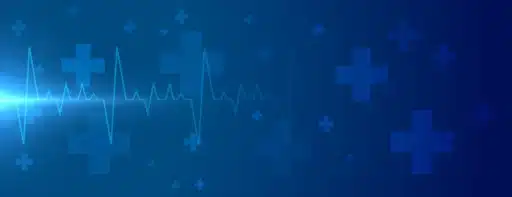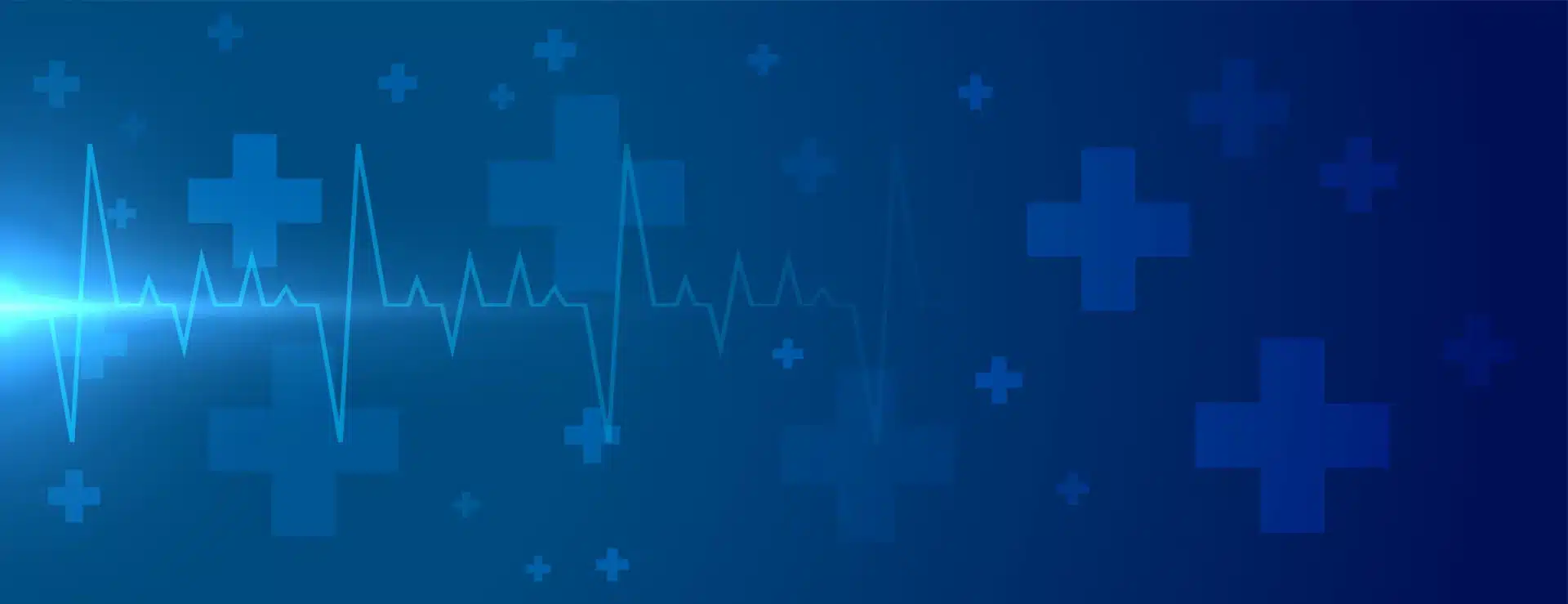Table of Contents
Living with back pain changes how we do everyday things. It affects our health and happiness. A herniated disc is often the cause behind this pain. It can lead to serious discomfort and make it hard to move around. Understanding what a herniated disc is can help manage it better. This guide aims to explain the basics of herniated discs. It will look at causes and treatment options.
Knowing more about herniated discs can help us prevent and treat them. There are many ways to treat this condition. These include changing our lifestyle, taking medications, or sometimes surgery. With the right treatment, people with a herniated disc can get better. They can go back to their normal lives.
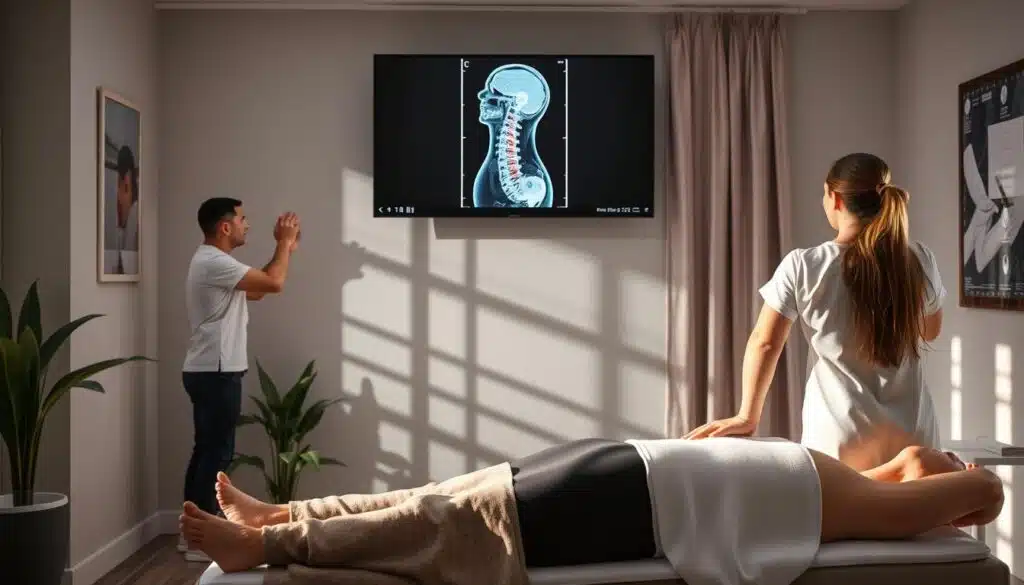
Key Takeaways
- A clearer comprehension of herniated disc causes and symptoms enriches one’s ability to seek proper care.
- Early identification of what is a herniated disc can potentially reduce long-term consequences and avoid chronic pain.
- Well-informed options mean better decisions when it comes to herniated disc treatment pathways.
- Therapeutic choices range from non-invasive to surgical interventions, emphasizing individualized treatment for herniated disc.
- No single therapy suits all, highlighting the necessity of personalized healthcare strategies in managing herniated disc conditions.
What is a Herniated Disc?
A herniated disc is a significant issue that affects the spine. It happens when the disc’s core breaks through a tear in the outer ring. This causes pain. This brief explains what a herniated disc is, describes it in detail, and discusses spine anatomy to understand its causes better.
Defining Herniated Disc Conditions
Knowing what a herniated disc is means understanding its effect on the spine. It can irritate nerves if disc material presses on them. This happens because of ruptures in the disc’s tough outer layer, letting the softer inside push out.
Understanding the Spine’s Anatomy
The structure of the spine is key to how herniated discs impact health. The spine has bones called vertebrae, with discs in between for cushioning and flexibility. These discs have a gel-like center and a firm outer layer. They help absorb shocks and allow the spine to move, which is essential for daily activities.
Herniated Disc vs Bulging Disc: Key Differences
Distinguishing between a bulging disc and a herniated disc is important for treatment. A bulging disc sticks out without breaking the outer layer. A herniated disc has a tear, allowing inner material to escape. Knowing the difference is crucial for treating them and improving spinal health.
Comprehending these points clarifies the issues herniated discs cause and the need for medical care.
The Causes Behind Herniated Discs
Knowing the causes of herniated disc helps in prevention and treatment. A herniated disc causes intense back pain and discomfort. This pain comes from a problem with a spine disc. How do you get a herniated disc is key in avoiding this pain.
What does a herniated disc feel like? It feels like sharp pain, numbness, and tingling. These symptoms happen because the nerve gets squished by the disc. Understanding herniated disc causes makes these symptoms clearer.
Many things lead to herniated discs. They include aging and lifestyle choices:
- Age-Related Degeneration: Getting older makes spinal discs less flexible. This makes them tear easily even with little strain.
- Physical Strain and Trauma: Lifting heavy things, moving suddenly, or an accident can stress the spine. This might cause a herniated disc.
- Lifestyle Choices: Not exercising, being overweight, and smoking can hurt disc tissue. This makes them more likely to herniate.
- Genetic Predisposition: Sometimes, genes play a big part in getting disc problems.
It’s important to know these causes to protect your spine. Starting early and living a spine-friendly life can really help. This can prevent herniated discs.
Identifying Herniated Disc Symptoms
Knowing herniated disc symptoms helps with getting help fast. Symptoms vary based on where the injury is in the spine. We’ll look at how symptoms differ across places and the urgent signs.
Recognizing Symptoms in the Upper Body
When the cervical spine is affected, it impacts the neck and arms. Symptoms include sharp neck pain, pain spreading to the arm, and numb or tingly hands or fingers. These symptoms can affect daily life a lot.
Lower Back Symptomatology
Herniated discs in the lower back, or lumbar spine, cause a lot of pain. People report back pain, sciatica, and weak muscles. Herniated disc lower back symptoms need careful attention to stop them from getting worse.
Emergency Signs: When to Seek Immediate Help
Some herniated disc emergency symptoms are really serious and need quick help. These include losing control over bladder or bowels, very weak legs, and pain getting much worse suddenly. Getting help early is crucial.
| Spine Region | Symptoms | Emergency Signs |
|---|---|---|
| Neck (Cervical) | Pain, numbness in arms, tingling in hands | Sudden severe neck pain, loss of coordination |
| Lower Back (Lumbar) | Localized back pain, sciatica | Loss of bladder/bowel control, severe leg weakness |
How Doctors Diagnose a Herniated Disc
To diagnose a herniated disc effectively, doctors need both clinical knowledge and advanced tech. They start with a thorough physical exam. MRI and X-rays are then used to tell herniated discs apart from other conditions like pinched nerves.
The Role of Physical Examinations
Physical exams are key for the first look at a herniated disc. Doctors use hands-on tests and review the patient’s history. They identify pain spots and check how well nerves are working.
Advanced Imaging Techniques: MRI and X-Rays
When symptoms suggest a herniated disc, imaging is the next step. MRI imaging is super useful because it shows the inside of the body in detail. It helps confirm a diagnosis. Also, X-rays can reveal issues with spinal alignment but aren’t as detailed as MRIs.
Differentiating Herniated Disc from Other Conditions
It’s important to tell a herniated disc from other spinal issues for the right treatment. MRIs and X-rays play a big role in this. Even though symptoms can be similar, the images provide clear evidence for diagnosing a herniated disc.
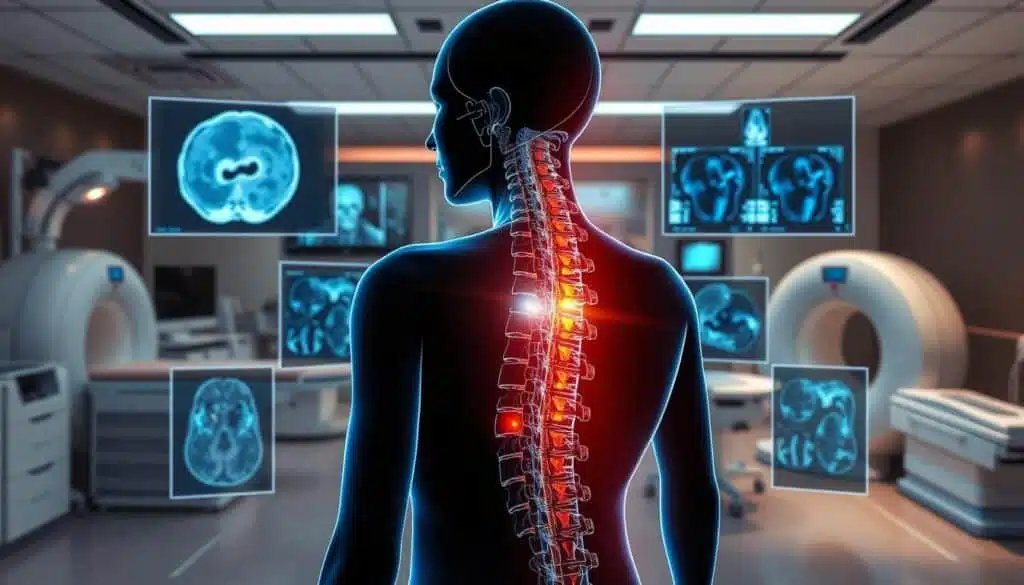
Below, see how imaging tests differ between a herniated disc and a pinched nerve:
| Condition | MRI Results | X-Ray Findings |
|---|---|---|
| Herniated Disc | Shows disc protrusion | May show vertebral misalignment |
| Pinched Nerve | Possible nerve root impingement | Often normal |
Non-Surgical Treatment Options
If you are dealing with a herniated disc, know that surgery isn’t your only choice. There are non-surgical ways to ease the pain and improve how you move. Let’s talk about options like medicines, physical therapy, chiropractic care, and special injections. These methods are key in treating a herniated disc without surgery.
Medications to Manage Disc Pain
Starting with medication is common for herniated disc treatment. NSAIDs, muscle relaxants, and nerve pain meds can lessen pain and swelling. These drugs are crucial for reducing pain and making recovery easier.
Physical Therapy and Its Benefits
Physical therapy is a big part of getting better. Therapists create custom exercises that ease pain and strengthen back muscles. Doing these exercises helps support your spine. This reduces future injury risks and teaches good posture habits.
Chiropractic Care for Herniated Disc
Chiropractic treatment involves spine adjustments by skilled chiropractors. It aims to improve how well your spine works, takes pressure off your nerves, and helps your body heal itself. It’s great for those who wish to avoid drugs and surgery.
Injections for Pain Relief
For tough cases, doctors might suggest injections. These shots, often corticosteroids, go right to the painful area to cut down inflammation and pain. They are usually part of a treatment plan that includes physical therapy and chiropractic care.
| Treatment Type | Description | Primary Benefits |
|---|---|---|
| Medications | Includes NSAIDs, muscle relaxants, and nerve pain medication. | Reduces inflammation and alleviates pain. |
| Physical Therapy | Includes exercises and routines to strengthen spine support. | Enhances flexibility, supports the spine, reduces the risk of further injury. |
| Chiropractic Care | Spinal adjustments by certified professionals. | Improves spinal function and promotes natural healing. |
| Injections | Corticosteroids injected directly at the painful site. | Direct inflammation and pain management. |
The Role of Exercise in Herniated Disc Recovery
Exercises for a herniated disc are key to a better recovery. They help speed up the healing and make results better. These exercises increase movement, strengthen your core, and reduce pain by fixing your posture. Usually, doctors suggest both stretching and strength exercises.

Stretching keeps your muscles flexible. This reduces tension and pressure on your spine. Strength exercises, tailored for herniated disc issues, strengthen spine-supporting muscles. This reduces the chance of further injury to the discs.
- Hamstring stretches for more lower back flexibility.
- Gentle yoga poses for a stronger, more flexible spine.
- Core strengthening exercises for better spine support.
Selecting exercises that fit your specific needs and condition is critical. The table below shows which stretches and strength exercises are safe and effective. This can guide you during your herniated disc recovery.
| Stretch Exercises | Strength Exercises |
|---|---|
| Wall hamstring stretch | Pelvic tilt |
| Knee to chest stretch | Bridging |
| Piriformis stretch | Lower back rotational stretch |
Mixing these safe and effective exercises into your routine supports herniated disc recovery. It does this by easing symptoms and improving the health of your spine. Teaming these workouts with medical advice and regular check-ups leads to a stronger, healthier spine.
Surgical Procedures for Herniated Disc
If non-surgical ways don’t help with herniated disc symptoms, an operation for herniated disc might be needed. Herniated disc surgical treatment options vary. They depend on the patient’s condition, offering different benefits and risks.
Herniated disc spinal surgery can involve different techniques. Techniques like discectomy, laminectomy, and spinal fusion are common. These can greatly reduce pain and help patients move better, especially if the disc damage is bad.
| Procedure | Description | Risks | Benefits |
|---|---|---|---|
| Discectomy | Removal of the damaged disc part to relieve nerve pressure. | Possible nerve damage, infection, bleeding. | High success rate in pain relief. |
| Laminectomy | Removes bone over the nerve root to make more space. | Spinal instability, risks of spinal fluid leak. | Helps numbness and weakness. |
| Spinal Fusion | Fuses vertebrae to stop the pain from movement. | Risk of disease near fused segment, long recovery. | Brings lasting spinal stability. |
Choosing the right herniated disc surgical treatment depends on many things. Factors include symptom severity, disc location, and patient health. Talking to a spine expert is key to making a good choice about herniated disc spinal surgery.
Post-Operation Recovery: What to Expect
Knowing what comes next after herniated disc surgery is key to a good recovery. We will talk about what you can expect during the healing process. You’ll learn about the timelines and the changes you might need to make.
Short-Term Recovery Timeline
The days just after surgery are very important. You might go home a few days after the operation. Pain control and avoiding some activities help prevent problems and aid healing.
Long-Term Healing and Rehabilitation
Recovery times can differ a lot. Rehab often starts a few weeks after surgery. It’s crucial for getting back strength and movement. Regular check-ups are needed to keep track of your healing.
Lifestyle Adjustments Post-Surgery
Making changes in your life helps you recover better. Using good posture, keeping a healthy weight, and eating well are important. It’s also wise to stop smoking and lower other health risks.
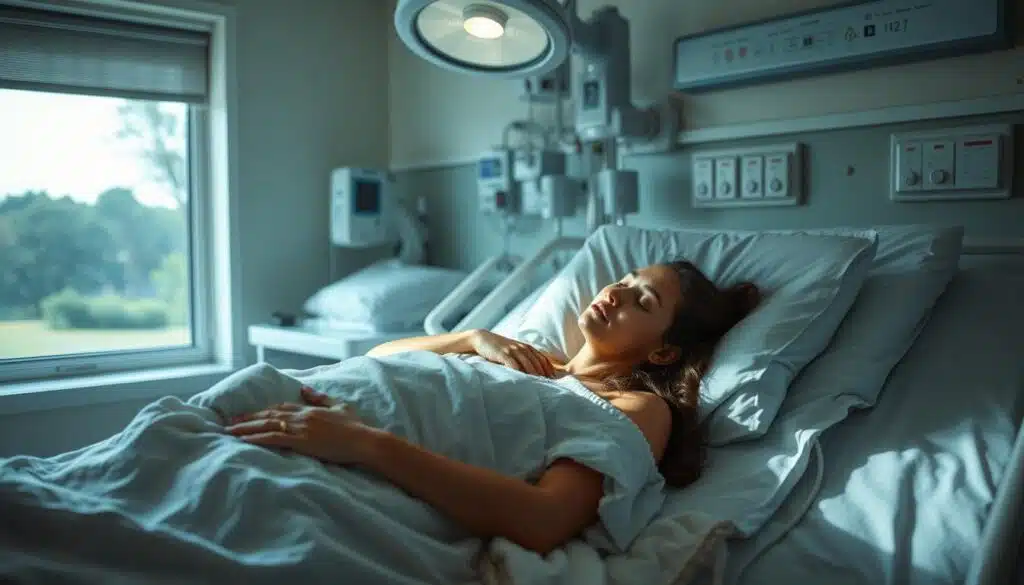
For more information, here’s a table that shows typical recovery stages and what you should do at each step.
| Phase | Timeline | Recommended Actions |
|---|---|---|
| Immediate Post-Surgery | 1-4 weeks | Rest, pain management, very limited mobility |
| Early Recovery | 1-3 months | Begin physical therapy, gradual increase in daily activities |
| Late Recovery | 3-6 months | Return to normal activity levels, focus on strengthening exercises |
| Long-Term Management | 6 months and beyond | Maintain active lifestyle, regular check-ups |
Assessing the Efficacy of Herniated Disc Treatments
The journey to recovery for herniated disc patients involves a few steps. Evaluating the herniated disc treatment effectiveness is key. Doctors consider pain relief, improved mobility, and how long the benefits last to judge if treatments work.
Patients often ask about the best painkiller for herniated disc problems. The most valued medications ease pain well without bad side effects. These are crucial in the early treatment phases.
Discussing the overall treatment for herniated disc success rate is important. It includes looking at clinical data and what patients say about their recovery. These insights help figure out if a treatment truly works.
Assessing treatment outcomes includes looking at quick pain relief and the spine’s health and function over time.
- Reduction in pain and discomfort
- Increased range of motion and flexibility
- Decreased reliance on pain medication over time
- Improved quality of life
| Treatment Method | Immediate Relief | Long-term Success |
|---|---|---|
| Physical Therapy | Varied | High |
| Chiropractic Care | Moderate | Medium |
| Painkillers | High | Low |
| Surgery | High | Very High |
In conclusion, measuring the success of herniated disc treatments involves many factors. These include quick pain relief, long-term health improvement, and how happy patients are with their results. As such, every treatment plan needs to be tailor-made. It should focus on both medical outcomes and fitting the patient’s life and health.
Understanding the Long-Term Outlook for Herniated Disc
Living with a herniated disc can start with acute pain and then lead to managing chronic conditions. It’s important to understand the long-term effects. Knowing how to manage chronic pain and using therapeutic exercises is crucial.
Preventing further issues by following prevention methods can help. This is key for a better quality of life and sustainable recovery.
Chronic Pain Management Techniques
Chronic pain from a herniated disc can be very tough. Treatment plans may include medication, physical therapy, and changing your lifestyle. Using natural pain relief like heat or cold therapy, along with physiotherapy, can help stay mobile and lower pain.
Seeing healthcare providers regularly makes sure your pain management plan fits your needs. It helps you take an active role in staying healthy.
Importance of Ongoing Therapeutic Exercises
Doing therapeutic exercises is very important for herniated disc care. Activities like walking, swimming, and stretching are key for your spine. They strengthen spine-supporting muscles and improve healing blood flow.
Doing these exercises often, with a professional, keeps the spine flexible. This helps avoid future injuries.
Preventing Recurrence: Best Practices
- Maintain a healthy weight to reduce pressure on the spine.
- Adopt proper posture especially when sitting for long periods.
- Regularly update and personalize exercise routines to enhance core stability.
- Lifestyle choices like quitting smoking, which can deteriorate disc health, should be considered.
It’s good to watch for signs that your herniated disc is getting better, like less pain. These signs show the treatment is working.

Below is a table outlining key aspects discussed and their relevance to the long-term management of a herniated disc.
| Aspect | Importance | Recommended Actions |
|---|---|---|
| Chronic Pain Management | Essential for quality of life | Medication, Physiotherapy, Lifestyle Mods |
| Therapeutic Exercises | Crucial for muscle and spine health | Walking, Swimming, Stretching |
| Prevention Strategies | Minimize risk of recurrence | Weight management, Correct posture |
Pain Management: Best Practices for Comfort
If you’re suffering from a herniated disc, finding the right pain relief can change your life. We’ll look at effective treatments and medication tips here. These can make a big difference for those with herniated discs.
To manage herniated disc pain, use a mix of treatments: medication, changing your lifestyle, and sometimes special therapies. Knowing which methods work best is key.
- Medication: Starting with the right painkiller is usually the first step. For mild pain, over-the-counter drugs like NSAIDs are suggested. For severe pain, your doctor may prescribe stronger medicine.
- Physical Therapy: Physical therapy involves exercises that reduce pain and strengthen spine-supporting muscles. This lessens pressure on the disc.
- Heat and Cold Therapy: Heat or ice packs can lower inflammation and dull sharp pain. This offers quick relief.
| Treatment Type | Description | Typical Duration |
|---|---|---|
| Medication | NSAIDs or prescribed painkillers to reduce inflammation and manage pain. | Varies based on individual needs and responses. |
| Physical Therapy | Custom exercises to strengthen back muscles and improve flexibility. | Several weeks to months. |
| Heat/Cold Therapy | Application of heat packs or cold compresses to alleviate pain. | Use as needed, typically 15-20 minutes per session. |
Using these methods together often brings the best relief. It’s also vital to work closely with your doctor. They can help adjust your treatment plan for better comfort and progress.
Alternative Therapies for Herniated Disc Management
Exploring herniated disc alternative treatment options can help many. This section talks about yoga, acupuncture, and massage therapy for herniated disc care.
Yoga for herniated disc is a good choice. It uses gentle stretches and strengthening exercises. These can ease spine pressure and boost spinal health.
Some yoga poses also make the back more flexible and strong. This can help lessen problems caused by herniated discs.
Another helpful method is herniated disc acupuncture. This technique puts needles at certain body points. It aims to wake up the nervous system and make the brain release pain-easing chemicals. This process can cut pain and make moving easier for those with herniated discs.
Herniated disc massage therapy is key for spinal issues too. It eases muscle tension and spasms that herniated discs often bring. Improved blood flow to the area helps heal and reduces pain.
- Yoga increases flexibility and support for the spine.
- Acupuncture may reduce the reliance on pain medications.
- Massage therapy enhances blood flow and relieves muscle spasms.
These alternative therapies are helpful but should be part of a bigger care plan. Always talk to a healthcare pro to find the best plan for you.
Conclusion
Looking back at herniated discs, we’ve learned a lot. We covered its anatomy and the many ways it can be treated. Herniated disc major points highlight the need to fully understand this condition. Knowing the causes and symptoms helps doctors find the right treatment.
This article gave a detailed summary of herniated disc care and treatment. Non-surgical methods like medication and physical therapy are often tried first. If these don’t work, surgery might be needed to ease pain and improve movement. Long-term care, including regular exercise and pain management, is key to keep your spine healthy and prevent further issues.
In our final words on herniated disc treatment, we stress the importance of personalized care. Since everyone reacts differently to treatments, a plan that’s just for you is vital. Working together with your doctor is the best path to recovery. This guide aims to give you the knowledge and confidence to deal with a herniated disc.
FAQ
What is a Herniated Disc and How Does It Occur?
A herniated disc happens when the soft center of a spinal disc breaks through a tear in its outer ring. This is often due to aging, sudden strain, or injury. It causes pain by pressing on nearby nerves.
How Can I Tell if I Have a Herniated Disc?
The symptoms of a herniated disc depend on where it is and if it’s pressing on a nerve. You might feel pain, numbness, or weakness in the area served by the nerve. Neck or lower back pain are common signs. Always get checked by a doctor to know for sure.
What’s the Difference Between a Bulging Disc and a Herniated Disc?
A bulging disc sticks out between the vertebrae but doesn’t break through, typical with aging. A herniated disc means the center has burst through the outer ring. Herniated discs tend to be more painful and often need targeted treatment.
Can a Herniated Disc Heal On Its Own?
Yes, a herniated disc can often heal with rest, therapy, and medicine. The body can sometimes absorb the herniated part over time. But, recovery can vary, and some cases may need more help.
What Non-Surgical Treatments Are Available for a Herniated Disc?
For a herniated disc, one can try medication, physical therapy, chiropractic work, or steroid shots. These methods focus on reducing pain, improving movement, and healing.
What Exercises Are Recommended for Someone with a Herniated Disc?
Doing gentle stretches and exercises can help those with a herniated disc. A focus on core strength, low-impact aerobics, and specific exercises from a healthcare pro is best.
When Is Surgery Necessary for a Herniated Disc?
Surgery may be needed if other treatments don’t ease the symptoms, if muscles weaken a lot, or if there’s nerve damage. Surgical choices include microdiscectomy, laminectomy, or sometimes spinal fusion.
What Should I Expect During Recovery After Herniated Disc Surgery?
Post-surgery, expect pain management, rest, and slowly getting back to activities. The recovery involves initial pain control and mobility, then more physical therapy and exercises. Always listen to your doctor’s advice to heal well.
Are There Any Alternatives to Traditional Medicine for Managing Herniated Disc Pain?
Yes, alternatives like yoga, acupuncture, and massage therapy can help. They should complement main treatments and be discussed with a doctor to make sure they’re safe for you.
How Effective Are Herniated Disc Treatments and How Long Does It Take to Feel Better?
The success of herniated disc treatments varies by person. Many improve in weeks to months with non-surgical options. Recovery time and effectiveness depend on the herniation’s severity, treatment plan, and personal health.

